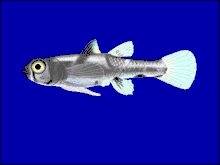Dwarf pygmy goby
The dwarf pygmy goby or Philippine goby[2] (Pandaka pygmaea) is a tropical species of fish in the subfamily Gobionellinae from brackish water and mangrove areas in Southeast Asia.[1][3] It is one of the smallest fish species in the world. Males reach maturity at a standard length of 0.9 cm (0.35 in) and can reach up to 1.1 cm (0.43 in) in standard length, while the females can grow up to 1.5 centimetres (0.59 in) in total length.[3] Adults weigh around 4 milligrams (0.00015 oz).[4] It is known as bia and tabios in the Philippines.[5]
| Dwarf pygmy goby | |
|---|---|
 | |
| Scientific classification | |
| Domain: | Eukaryota |
| Kingdom: | Animalia |
| Phylum: | Chordata |
| Class: | Actinopterygii |
| Order: | Gobiiformes |
| Family: | Oxudercidae |
| Genus: | Pandaka |
| Species: | P. pygmaea |
| Binomial name | |
| Pandaka pygmaea Herre, 1927 | |

Distribution and habitat
P. pygmaea was initially reported as being endemic to Malabon, Metro Manila in the Philippines, where found at shady river banks.[3][5] The species has now been extirpated from this area as it was reclaimed, leading to its status as critically endangered by the IUCN.[1] More recently, it has been discovered at a range of other locations in Southeast Asia, including Culion Island, Bali, Sulawesi and Singapore.[1][3] As part of the aquarium trade, it was imported into Germany in 1958.[3]
P. pygmaea lives in shallow, tropical brackish water and mangrove areas where mainly found on muddy bottoms or among plants. Also known before as National Fish in the Philippines on 1994 until recently they changed it to milk fish.[1][3]
Appearance and anatomy
A colorless and nearly transparent species, the dwarf pygmy goby has a moderately elongated and robust body. Males are slender with nearly straight dorsal and ventral profiles, while the females appear stouter with the dorsal profile slightly curved, the belly protuberant, and the ventral outline strongly arched.[5][3]
The head of the P. pygmaea is large and blunt. The head and nape are naked. The upper and lower profiles converge and are pointed if viewed from the sides. The head is characteristically broader than deep. The head is very short, broad and rounded. The mouth is very oblique, with a projecting lower jaw and chin. The posterior angle of the maxillary extends beneath the anterior part of the eye, up to the middle of pupil. It possesses two rows of teeth in each jaw. The outer row of teeth inside the upper jaw is larger and more widely spaced, while the inner row is characteristically minute. The first dorsal fin is low, much in advance of the second dorsal fin but not reaching the second dorsal fin when depressed. The pectoral and ventral fins are pointed, with the latter about as long as the former or longer. The anal papilla is very short and rounded in females, but is longer and very slender in males.[5][3]
P. pygmaea have dark spots, which forms 4 cross-bands, over the sides of its body. The bases of the fins are heavily pigmented, except for the ventral fins. It has 22 to 25 scales in longitudinal series.[5][3]
Behavior
Miscellaneous
Pandaka pygmaea was once portrayed on a Philippine ten centavo coin where, uniquely for a wildlife portrayal on coinage, it is depicted at life-size. The genus name is derived from the Filipino word pandak, meaning "dwarf" or "short of stature".[6]
See also
References
- Palla, H.P.; Torres, A.G.; Kesner-Reyes, K.; Guino-o, R.S. II, Ballad, E.L.; Ame, E.C.; Gonzalez, J.C.T.; Reyes, A.T.; Angeles, I.J.P.; Leander, N.J.S.; Gaerlan, R.S.P.; Garcia, M.P.C.; Cecilio, M.A.F.; Mamalangkap, M.D. (2021). "Pandaka pygmaea". IUCN Red List of Threatened Species. 2021: e.T15939A162163071. doi:10.2305/IUCN.UK.2021-2.RLTS.T15939A162163071.en. Retrieved 20 November 2021.
{{cite journal}}: CS1 maint: multiple names: authors list (link) - Animals. pawnation.com
- Froese, Rainer; Pauly, Daniel (eds.) (2017). "Pandaka pygmaea" in FishBase. February 2017 version.
- Balcombe, J. (2016). What a Fish Knows: The Inner Lives of Our Underwater Cousins. p. 16. ISBN 9780374714338.
- "Pandaka pygmaea (Herre 1927)". Archived from the original on 23 October 2010. Retrieved 14 July 2007., Guide to the Philippine Flora and Fauna, Band IX, ISBN 971-10-2627-9 (undated).
- "Pandak". WikaPinoy.com. Archived from the original on 2012-04-25. Retrieved 2011-11-14.
External links
 Media related to Pandaka pygmaea at Wikimedia Commons
Media related to Pandaka pygmaea at Wikimedia Commons Data related to Dwarf pygmy goby at Wikispecies
Data related to Dwarf pygmy goby at Wikispecies- Photograph and Description of Pandaka pygmaea, Herre, 1927, Dwarf pygmy goby, Pandaka pygmaea, NSMT-P 66047, 1.0 cm SL, Fishes of Libong Island, Kahaku.Go.jp, retrieved on July 14, 2007
- Pandaka pygmaea, Herre, 1927, Taxonomic Serial No.: 172193, ITIS.gov, retrieved on: July 14, 2007
- Chen, Loris. Gobies: Going, Going, Gone? A WebQuest for 6-8th Grade (Science) (lchen@wyckoffschools.org), Ocean Biographic Information System, Census of Marine Life, Rutgers, The State University of New Jersey, 2002-2007. IOBIS.org, retrieved on July 14, 2007
- Fenner, Bob. "True" or Combtooth Gobies, the Family Gobiidae, Wetwebmedia.com (undated), retrieved on July 14, 2007
